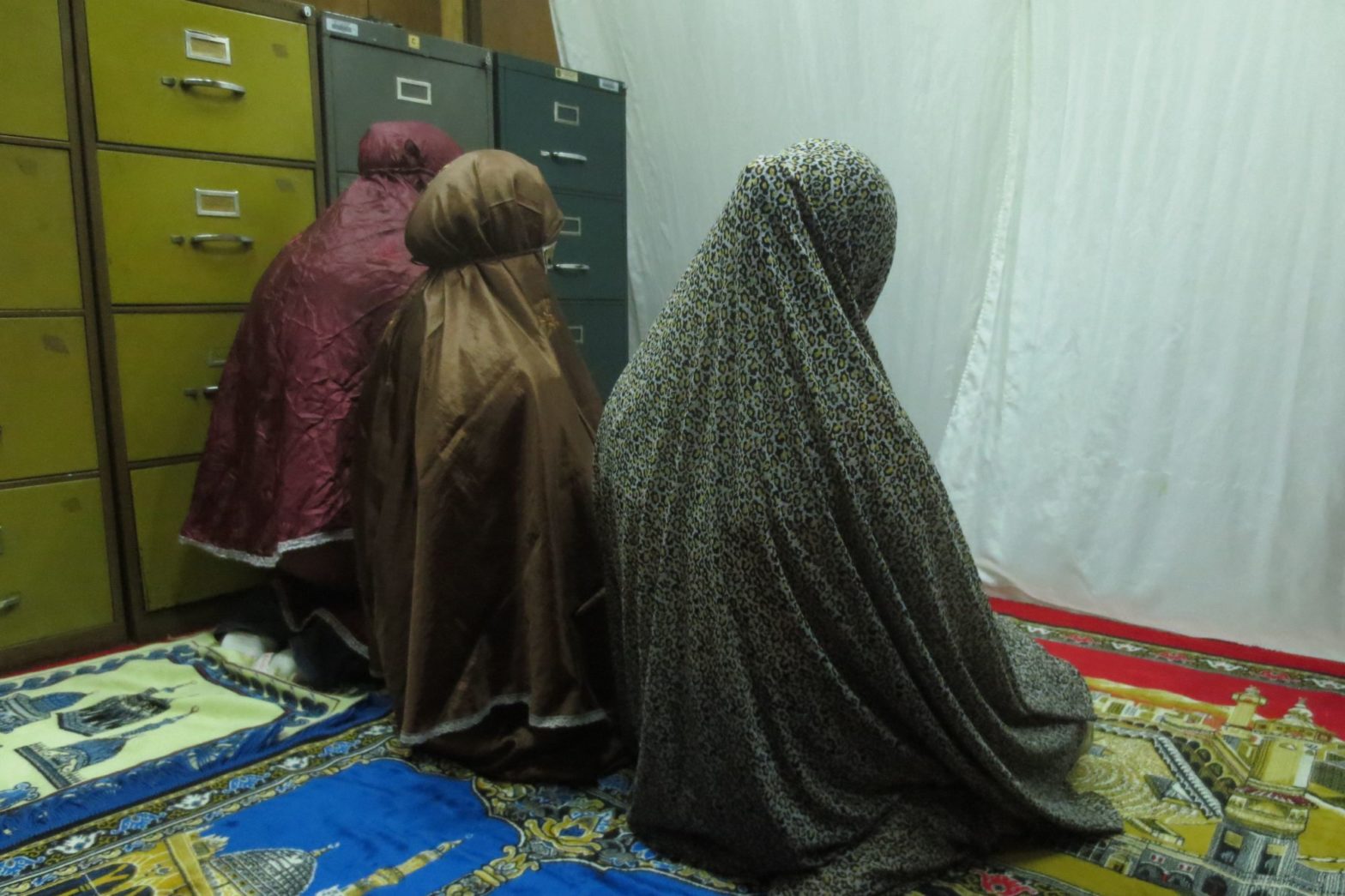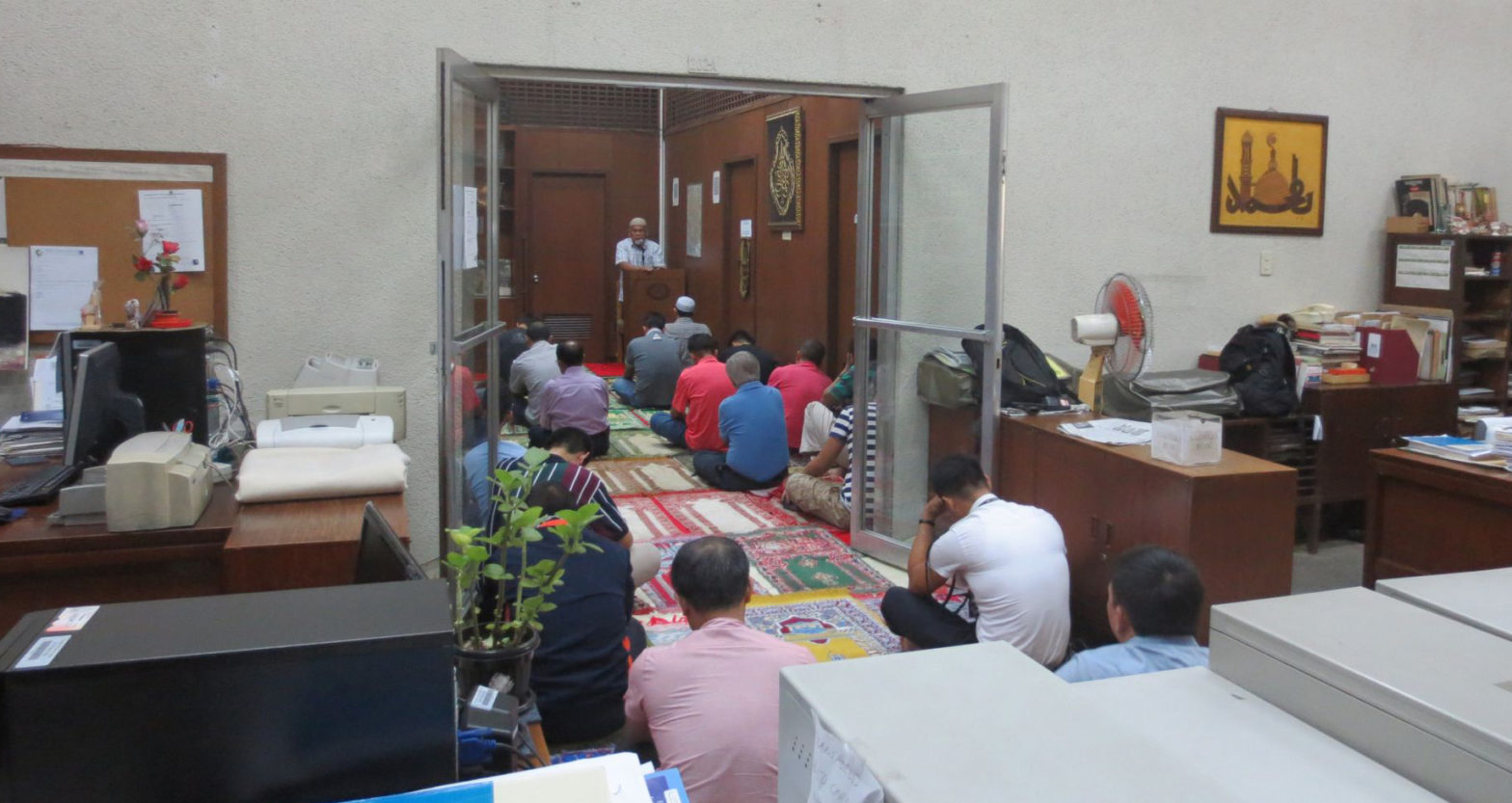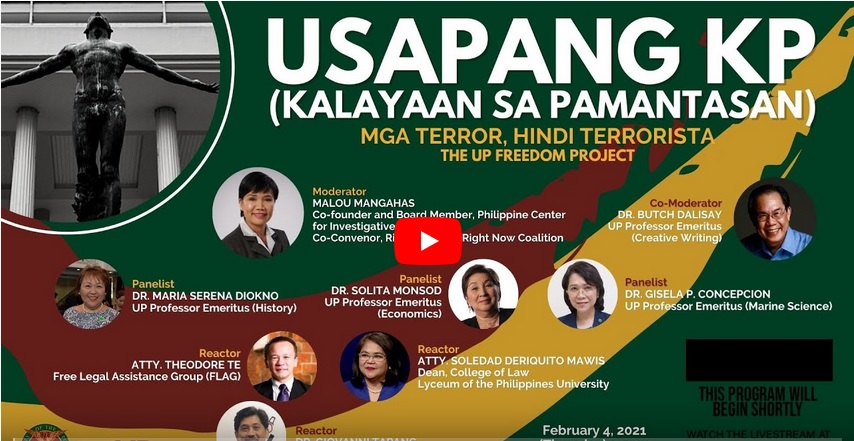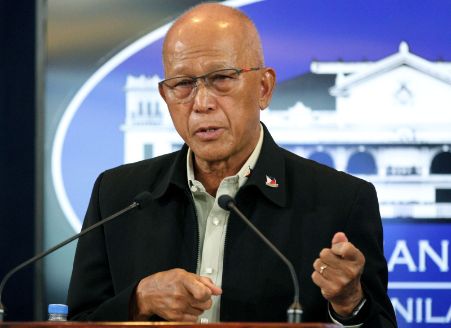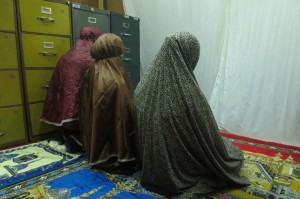 By JON LINDLEY AGUSTIN, KATRIA AYANNA ALAMPAY, JHESSET THRINA ENANO, ELIZABETH ESCANO AND LUIS ADRIAN HIDALGO.
By JON LINDLEY AGUSTIN, KATRIA AYANNA ALAMPAY, JHESSET THRINA ENANO, ELIZABETH ESCANO AND LUIS ADRIAN HIDALGO.
(First of two parts)
The roughly five-square-meter room at the Institute of Islamic Studies (IIS) in Romulo Hall at the University of Philippines-Diliman is just a storage area. But for two hours around noon every Friday, it transforms into a makeshift prayer room for female Muslim professors, students and visitors.
With barely enough room for four to stand in a row, the space filled with office equipment, furniture, and television set becomes a tiny, temporary mosque. And with an out-of-place cutout image of the Virgin Mary taped to a discarded computer monitor bearing silent witness, the women sit, stand and bow on colorful and intricately designed prayer mats.
At about the same time, the IIS conference room is cleared of chairs and a table, and fills with male Muslim worshippers. Soon enough, a long and deep chant signaling their call for prayer resonates throughout the decades-old building.
Prayer is a fundamental part of life of Muslims who pray five times a day, specially now during the holy month of Ramadan. And this is how the UP Muslim community copes with the lack of prayer areas, converting even the tiniest and unlikeliest rooms into spaces for worship. The situation has prompted them to question how the state university can fulfill its vision of being a haven for cultural and religious diversity, when they have no place to pray.
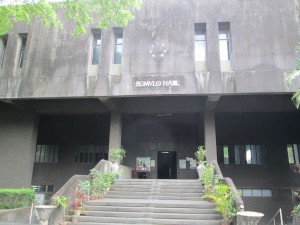 The community has been asking UP for its own mosque, but acceding to that request is not a simple matter. There is the question of where to get funds and where to build the mosque. As a government institution, UP is not allowed to appropriate property for any religious sect, church or denomination. Already, officials say it was wrong for UP to have built the two churches on campus—the Catholic and Protestant churches built decades ago—so to build a mosque would mean another mistake.
The community has been asking UP for its own mosque, but acceding to that request is not a simple matter. There is the question of where to get funds and where to build the mosque. As a government institution, UP is not allowed to appropriate property for any religious sect, church or denomination. Already, officials say it was wrong for UP to have built the two churches on campus—the Catholic and Protestant churches built decades ago—so to build a mosque would mean another mistake.
In an ideal setting, the Muslim women who pray at the IIS’ storage area would have had 45 times as much space—225 square meters that could accommodate up to 250 people. This area would have been in the mezzanine of a masjid, or mosque, in a masjid complex the UP Muslim community proposed in 2003, one of many proposals it had submitted to the university.
But inconsistencies from the proponents of the mosque themselves and from the different UP administrations over the years have obstructed the construction of a decent Muslim prayer place on campus. Add to this the long running issue over the legality of having a masjid or mosque within the secular state university.
As early as the 1950s, UP Muslim students were already petitioning for a place of worship. Then UP President Enrique Virata consulted the Department of Justice on whether UP could lease a portion of the campus to the UP Muslim Association for the construction of a mosque.
A 1958 DOJ opinion settled the question. The request may be granted, the DOJ said, provided the UP Muslim Association paid rent and got the same privilege given to other interested religious sects. It cited a 1956 opinion prohibiting discrimination against religious sects or denominations.
Maharlika Alonto, former president of the UP Muslim Students Association (UP MSA), the only Muslim student organization in the campus, said when she entered UP in 1999, there were already talks within the organization to push for a masjid because of the growing number of Muslims in UP Diliman.
Although still an obvious minority, The Muslim student population at Diliman stood at 151 for the second semester last school year.
UP MSA became more actively involved after Rommel Romato became the first Muslim to serve as chairperson of the University Student Council (USC) in 2002.
“For Muslims, we don’t have a proper place of worship. So I thought of bringing this to the attention of the administration and, fortunately, they listened to us,” he said.
By April 2003, UPD Task Force Masjid, a group of concerned individuals representing UP MSA, IIS and other Muslim members of the academe, came up with the design of the proposed masjid complex, which would occupy 6,400 square meters, cost P35.5 million and take two years to build.
The members then called on then chancellor Emerlinda Roman to discuss the proposal.
“The UP administration took the proposal seriously,” Romato said, recalling that Roman and other officials suggested that the task force create a foundation that would represent the community in its talks with the university administration and sponsors.
Heeding Roman’s advice, Alonto, Romato and then IIS Dean Carmen Abubakar established the UP Diliman Masjid Foundation in January 2004 to pursue the proposed UP Diliman Masjid and, more important, raise funds for the project. Abubakar served as its president.
Finding sources of funding then was not an issue, according to Alonto, who was elected treasurer-in-trust of the foundation. It looked to Arabic countries and foundations for funding.
“If it’s for an academic institution, they’re kind of generous,” Alonto said. Foreign benefactors such as the Sultan of Brunei and the Embassy of Saudi Arabia pledged to donate—but only if the project were approved by the university and land was provided.
The approval never came. In March 2004, Roman and then Vice Chancellor for Administration Ernesto Pineda informed the foundation that based on the UP Diliman Land Use Plan of 1994, the university could no longer accommodate a place of worship.
Instead, the university officials suggested a Muslim-inspired dormitory where a mushallah, or prayer area, could be housed. This, they said, would provide not only a proper place of worship for Muslims in UP Diliman but also address the university’s need for additional housing.
The foundation complied. On Sept. 29, 2004, Roman sent Romato a two-page letter detailing an agreement in which the university would lease to the UPD Masjid Foundation a 3,000-square-meter property within the Diliman campus to establish the Muslim-inspired dormitory with mushallah.
According to the proposed agreement, the lease would run for 25 years and would be renewable for another 25 upon mutual consent from the two parties. The foundation was to contribute a tenth of the gross receipts of the project to the university.
Romato was asked to sign the letter to signify that the foundation agreed to the terms and conditions of the agreement in principle.
He never did.
Two years later, members of the foundation, including Shahana Abdulwahid, who would later be USC chairperson herself and much later, student regent, would bring up the proposal with the newly appointed chancellor, Sergio Cao, during a courtesy call on June 26, 2006.
Cao pointed out Romato’s failure to sign the letter from Roman and accept the terms on behalf of the foundation.
Told that some members of the foundation had questioned some provisions, Cao told Romato, “You could have written. The university offered terms but there was no acceptance.”
Romato, who is now based in London, said in an interview that potential investors at the time had expressed reservations over the proposed 25-year lease. “It’s not that easy to find funders or investors who’d agree to that (25-year lease),” he said.
Romato also said that although he did not write back the Roman administration, he brought the problem to the attention of UP officials in a series of meetings.
“I cannot just decide on my own because if I commit or reply, it will be binding,” he said.
Minutes of the June 26 meeting with Cao also showed the UP Diliman chancellor expressing concerns over the funding of the project.
He also recommended that the foundation seek the help of Muslim congressmen.
“(R)ealistically, can the whole dorm project be done?” Cao had asked.
Romato and Alonto said the foundation was indeed having difficulty securing donors chiefly because the university had not allotted land for the prayer area.
Romato also said the UP’s proposal to build a dormitory instead of a place of worship that the foundation initially just wanted only complicated matters. “A prayer hall is already hard to maintain, what more a dormitory?” he said.
Cao also voiced out security concerns during the meeting. Abdel Disangcopan, president of MSA at the time, said the original plan was compared to Quiapo, known for the presence of many Muslim groups in the area. Romato said there were fears a mosque would attract “undesirable elements.”
Being the first step in the process, the chancellors’ response to the proposals is crucial, as it spells its possible fate in the autonomous unit.
Both former chancellors refused requests for interview. Roman, who is back at the Virata School of Business (formerly College of Business Administration) after serving as the first woman UP President from 2005 to 2011, said she barely remembers the proposals and referred the writers to current IIS Dean Julkipli Wadi.
Cao said he would rather not speak on the matter, now that he is no longer affiliated with the university. Now the president of Manila Tytana Colleges, he referred the writers to the Office of the Chancellor
(This report was submitted as a requirement of the authors’ Investigative Journalism class under VERA Files trustee and UP professor Yvonne T. Chua.)
(To be concluded)
